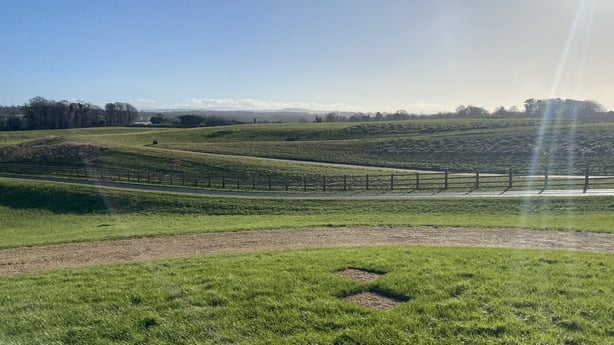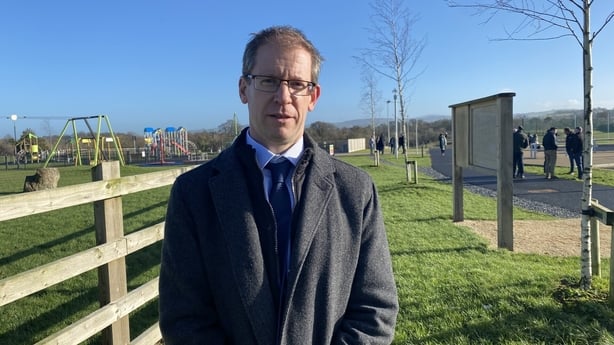A former landfill site in Naas, Co Kildare that caught fire in 2011 has been transformed into a public park.
Kerdiffstown Park officially opened today at a final cost of €66 million.
Significant remediation and engineering works had to be carried out at the facility, where household and construction rubbish once towered 116m above sea level, to make it safe for public use.
The opening ceremony with 400 pupils from the local Scoil Bhríde in Kill involved them forming a St Brigid's Cross.
The students said they hoped that Brigid would signify renewal and the coming of Spring.

There was a delay in opening the park last summer when Kildare County Council had to procure additional engineering facilities in the form of a low calorific flare to manage the landfill gas collection system at the site.
Of the final costs, Kildare County Council has spent €26 million since it took over the site in 2015, beginning construction in 2020.
"Building a park on top of a landfill, there's been lots of constraints in terms of what you can and can't do and the insulation of that landfill in terms of infrastructure, under what is now the park on top of it," explained senior engineer in the environment section of the council Chris Galvin.
He said there were plenty of engineering and scientific issues to be dealt with.
"The low calorific flare was part of the design and it's for a time when the landfill starts to produce less quality gas, so the methane content in the gas goes down, we need another flare which will burn at that lower level," Mr Galvin said.
Gas production at the landfill can vary over the seasons and across the year.
"We've two different flares to manage that and we've a team on-site managing all that gas to make sure we're managing it properly and environmentally, to make sure we comply with the license we have from the EPA as well," Mr Galvin said.
We need your consent to load this rte-player contentWe use rte-player to manage extra content that can set cookies on your device and collect data about your activity. Please review their details and accept them to load the content.Manage Preferences
Other things that have to be monitored by the council include leachate collection which involves a pipe network running under the N7 motorway taking runoff to the Oberstwon Wastewater Treatment Plant.
There are still 3 million square metres of rubbish under the park which has been capped and reshaped to form the park's hill and landscaped features.
Kildare County Council said the key thing from the start has been to give back to a community that had been blighted by the operation of the illegal dump site, which once spewed noxious air and gasses across the neighbourhood, forcing people to keep their windows closed, depending on the direction of the wind.
Signposts around the park asked the public not to smoke or light barbecues.

"It's probably coming into parks anyway that there's no smoking on site, from the point of view here that this is an historic landfil but from a health point of view its a good way to act when you're in a park anyway," said Mr Galvin.
"Also no naked flames, so barbecues and that type of thing but other than that the park is for use for everyone as every other park," he added.
Programme Manager of the Office of Environmental Protection at the Environmental Protection Agency Patrick Byrne said significant quantities of domestic and construction waste that were illegally dumped have now been made safe at this site.
"Capping it safely and making sure that it wouldn't impact on the environment long-term."
He said monitoring of the site will continue for decades.
"It's not a case of walking away so we would expect monitoring to continue for the foreseeable future," Mr Byrne said.
Kildare County Council said it has recycled 240 tonnes of tyres as part of the project.
Its opening comes more than two decades after the site, managed by Nephin Trading Ltd first began to cause a significant environmental and public nuisance with the EPA securing an injunction to prevent it continuing to operate the site in 2010.
The major fire which broke out the following year took almost a month to bring under control.
The EPA hopes that a fine of €20 million against the company and the prosecution and jailing of its former director will act as a "powerful deterrent" to such an environmental hazard happening again.







